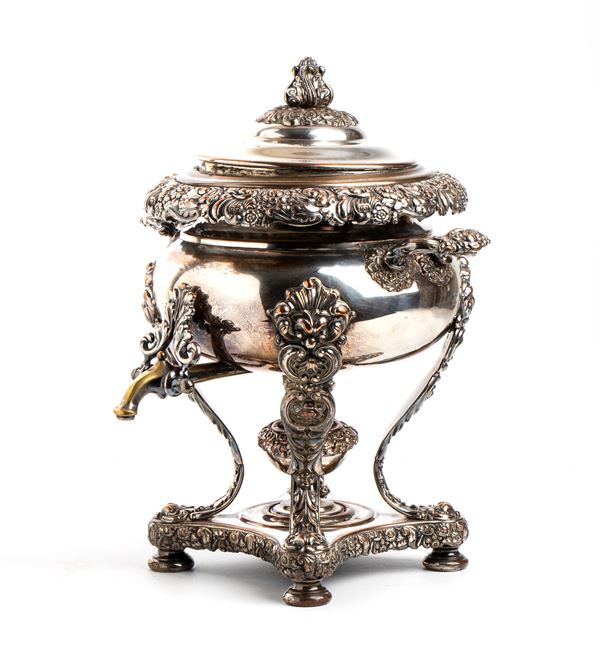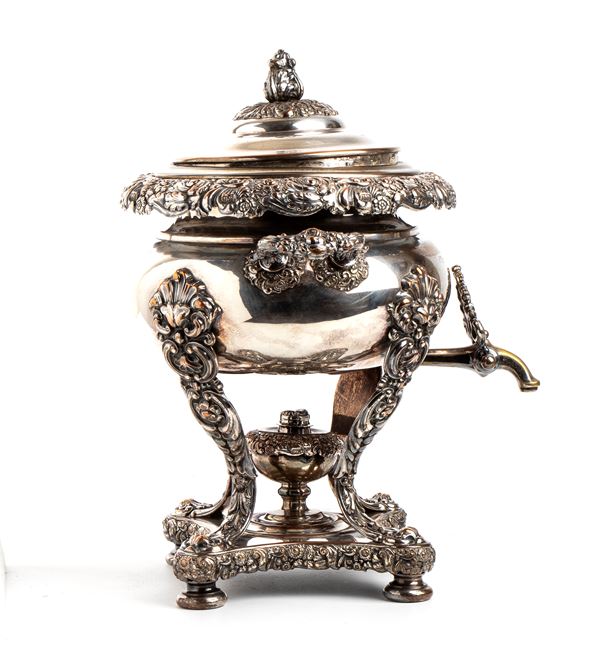309
English Victorian Old Sheffield Tea kettle, 19th century
a compressed spherical kettle displaying the typical foliate decorations on mounting and basement. Shaped base with central burner.
Literature:
From the late 18th century, the growth of the English industry led Sheffield, Birmingham, and London to flood the country with inexpensive household goods.
The city of Sheffield was the birthplace and main production center of this manufacturing industry, which later expanded, albeit with lesser success, to Russia, France, and the United States. Due to Sheffield’s strong historical association with this craft, there is today a widespread but incorrect tendency to group together under a single term a variety of objects made in different periods and using different techniques.
OLD SHEFFIELD – FUSED PLATE
These two interchangeable terms refer to objects made from a metal obtained by hot-rolling a thin sheet of sterling silver (925/1000) onto a copper core.
The original method, discovered in 1742 by Thomas Boulsover, a Sheffield cutler, was later refined by Matthew Boulton, the most prominent figure in Old Sheffield production. As a result, for the next 100 years, every article traditionally made in sterling silver was replicated using this composite metal.
Initially, the main buyers were the middle class, restaurateurs, and hoteliers. However, around 1780, the sharp increase in silver prices and the refinement of this manufacturing process finally convinced the public to accept these objects, as their durability was also guaranteed.
For approximately 50 years, the Sheffield plate industry thrived. However, as silver prices began to decline and labor costs rose, this labor-intensive process became progressively too expensive.
Many of the earliest Old Sheffield pieces were hallmarked in a way that misled the public into believing they were made of sterling silver. This led to the introduction of legislation in the late 18th century aimed at preventing such deception.
When Old Sheffield objects lack hallmarks, it is simply because there was no legal requirement to mark them. In fact, silversmiths strongly opposed mandatory stamping, as it would have meant paying taxes. As a result, today, only about 25% of Old Sheffield objects bear the maker's mark
From the late 18th century, the growth of the English industry led Sheffield, Birmingham, and London to flood the country with inexpensive household goods.
The city of Sheffield was the birthplace and main production center of this manufacturing industry, which later expanded, albeit with lesser success, to Russia, France, and the United States. Due to Sheffield’s strong historical association with this craft, there is today a widespread but incorrect tendency to group together under a single term a variety of objects made in different periods and using different techniques.
OLD SHEFFIELD – FUSED PLATE
These two interchangeable terms refer to objects made from a metal obtained by hot-rolling a thin sheet of sterling silver (925/1000) onto a copper core.
The original method, discovered in 1742 by Thomas Boulsover, a Sheffield cutler, was later refined by Matthew Boulton, the most prominent figure in Old Sheffield production. As a result, for the next 100 years, every article traditionally made in sterling silver was replicated using this composite metal.
Initially, the main buyers were the middle class, restaurateurs, and hoteliers. However, around 1780, the sharp increase in silver prices and the refinement of this manufacturing process finally convinced the public to accept these objects, as their durability was also guaranteed.
For approximately 50 years, the Sheffield plate industry thrived. However, as silver prices began to decline and labor costs rose, this labor-intensive process became progressively too expensive.
Many of the earliest Old Sheffield pieces were hallmarked in a way that misled the public into believing they were made of sterling silver. This led to the introduction of legislation in the late 18th century aimed at preventing such deception.
When Old Sheffield objects lack hallmarks, it is simply because there was no legal requirement to mark them. In fact, silversmiths strongly opposed mandatory stamping, as it would have meant paying taxes. As a result, today, only about 25% of Old Sheffield objects bear the maker's mark
€ 300,00 / 400,00
Estimate
€ 170,00
Starting price
Unsold
Live auction 328
Antique Furniture, Objects of Art, Curiosities
Antique Furniture, Objects of Art, Curiosities
with a selection of carpets
Palazzo Caetani Lovatelli, tue 4 March 2025
SINGLE SESSION 04/03/2025 Hours 15:30
Discover Similar Lots






